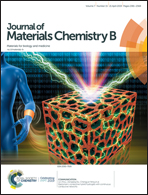Amorphous carbon modification on implant surface: a general strategy to enhance osteogenic differentiation for diverse biomaterials via FAK/ERK1/2 signaling pathways†
Abstract
Bone implants play a crucial role in bone repairing. Nevertheless, low capability of osteoinductivity and osteogenic differentiation for bone regeneration are disadvantages of bone implants. Therefore, it is imperative to develop a general and facile technology to promote the bioactivity of existing implants. Herein, a facile amorphous carbon-coating approach was developed to stimulate osteogenesis on diverse biomaterials, including bioceramics, biometals, and biopolymers via magnetron sputtering deposition. The results confirmed that the amorphous carbon-coating-modified surfaces could significantly enhance osteogenesis of bone marrow mesenchymal stem cells (BMSCs) on every kind of biomaterial surface. Furthermore, it was demonstrated that the FAK/ERK1/2 signaling pathways were involved in the osteogenic effects of this amorphous carbon coating. The bone regeneration ability using the calvarial bone defect model of rats confirmed that the amorphous carbon coating induced faster bone formation and mineralization, which suggested the effect of amorphous carbon coating on stimulating osteogenesis in vivo. These results suggest that the approach involving modifying a surface with amorphous carbon provides a general and simple strategy to enhance the osteogenesis for diverse biomaterials, and this has promising potential for bone repairing applications.



 Please wait while we load your content...
Please wait while we load your content...